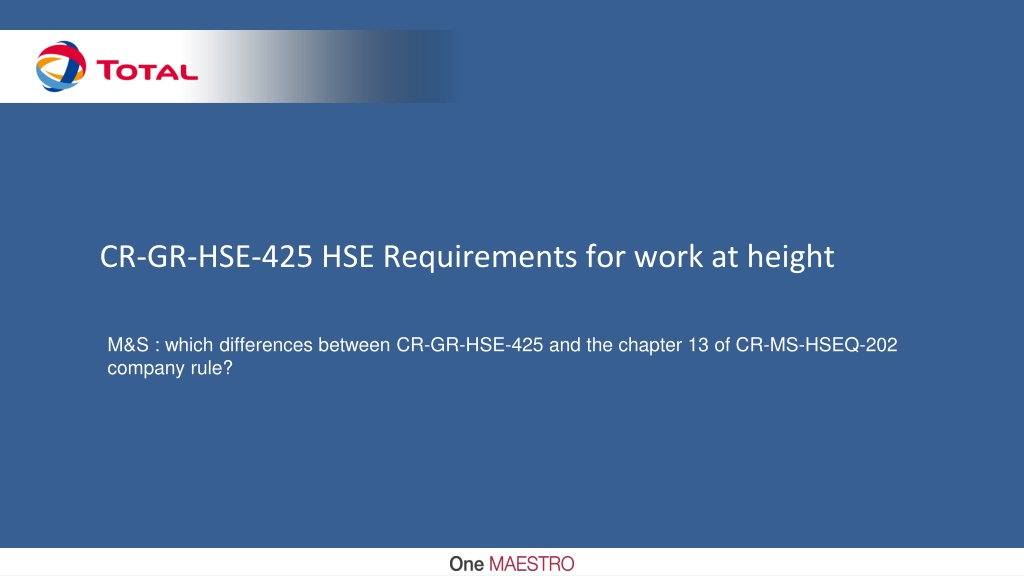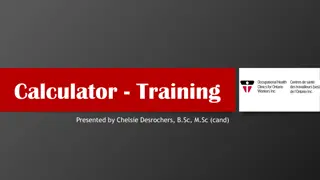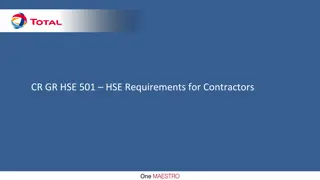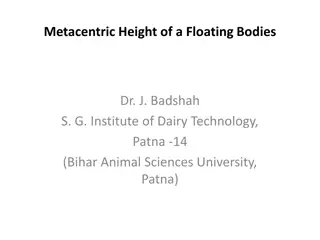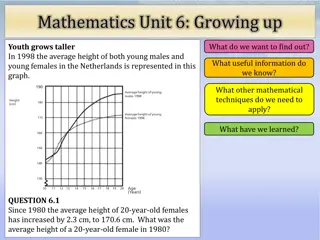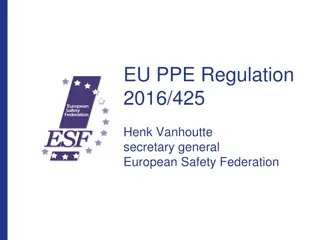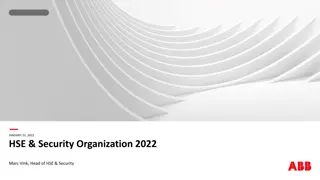CR-GR-HSE-425 vs. Chapter 13 of CR-MS-HSEQ-202: Work at Height Requirements Comparison
CR-GR-HSE-425 introduces new requirements for work at height, such as lowering the height of fall, widening risk considerations, managing removable guardrails, restricting the use of ladders as workstations, addressing the risk of dropped objects, implementing work permits, and ensuring rescue plans and proper safety equipment. The chapter also emphasizes risk analysis, prioritization of control measures, and management of collective protection and removable guardrails. These changes aim to enhance safety and address specific risks associated with working at height.
Uploaded on Sep 11, 2024 | 0 Views
Download Presentation

Please find below an Image/Link to download the presentation.
The content on the website is provided AS IS for your information and personal use only. It may not be sold, licensed, or shared on other websites without obtaining consent from the author. Download presentation by click this link. If you encounter any issues during the download, it is possible that the publisher has removed the file from their server.
E N D
Presentation Transcript
CR-GR-HSE-425 HSE Requirements for work at height M&S : which differences between CR-GR-HSE-425 and the chapter 13 of CR-MS-HSEQ-202 company rule?
Main New Requirements of the CR-GR-HSE-425 Lowering from 2.0 to 1.5 m of the height of fall characterizing work at height ( 1 - Purpose) Widening of risks to consider, beyond the fall of person (Requirement 3.1.1) Control and Management of Removable Guardrails (Requirement 3.2.2) Step ladders and portable ladders not used as a workstation (Requirement 3.3.1) Management of risk against dropped objects (Requirement 3.3.2) Work covered by a work permit 1.5 m: harness worn and tied off (Requirement 3.4.4); permanent or temporary anchor points are identified (Requirement 3.3.5) Rescue plan at height (Requirement 3.3.6) Wearing a chin-strap helmet for moving around and working at height (Requirement 3.4.3) 2
REQUIREMENTS OVERVIEW Risk Installation management Work Execution of work preparation assessment Requirement 3.1.1: Risk Analysis for Work and Moving Around at Height All works or moving around at height are subject to a risk analysis covering as a minimum, when applicable: The risk of personnel falling; The risk of dropped objects; The risk of electrocution in proximity or in contact with overhead power lines; The risk of crushing at height when using MEWP. New requirement to take into account the 4 risks related to working at height. Requirement 3.1.2: Prioritisation of Risk Control Measures A risk assessment on work at height defines the risk control measures to be implemented, as per the following order of priority: Limiting work at height (reducing risks at source); Installation of permanent and secured means of access and for work at height; Implementation of temporary equipment for collective protection (scaffolds, MEWP, fall arrest systems such as safety nets, etc.); Use of positioning techniques (rope access work) or personal protective equipment. Requirement aligned with most national regulations. Impact: No impact identified in terms of workload. 3
REQUIREMENTS OVERVIEW Installation management Risk Work Execution of work assessment preparation Requirement 3.2.1: Management of Collective Protection The condition of equipment required for access, moving and working at height, including their protective measures (caged ladders, access gate, guard rails, grating floors, etc.) is part of a periodic inspection program executed by designated personnel. Requirement already defined in Group s standards. Implementation to be reinforced, mainly due to several events of falling through gratings. Requirement 3.2.2: Management of Removable Guard Rails Removable guard rails are inventoried and the reason for their installation is justified. They are secured and flagged on site to ensure that no other activity can compromise their safety function. New requirement related to the event Normandy 2019 Impacts: Reinforcement of the inspection/maintenance programs for collective protections. Securing/signalisation of removable guard rails. 4
REQUIREMENTS OVERVIEW Work Risk Installation management Execution of work assessment preparation Requirement 3.3.1: Selection of Elevation Means to be Used Temporary equipment for work at height (scaffolds, MEWP, etc.) is selected in consideration of the work environment, the height to be reached and manufacturers instructions. Picking ladders (that do not have a platform secured on all four sides), standard stepladders where the upper section is not secured, and portable ladders are not used as workstations. New requirement related to the events Antwerp & SunPower 2019 . Requirement 3.3.2: Management of Risks Against Dropped Objects Tools, materials and equipment used during work at height are transported, handled and stored so as to prevent them from being dropped. The risk assessment defines any additional requirements for suitable protection against dropped objects, either at the work area (e.g. lateral protection devices such as netting), as the object is dropped (e.g. debris screen), or at ground level where a sufficiently large safety area is marked off. New requirement focusing on the topic (taking into account in Golden Rule 10, but not in formerGroup s rule). Impact: Purchase of secureworking platforms to current standards for some low-height works. 5
REQUIREMENTS OVERVIEW Work Risk Installation management Execution of work assessment preparation Requirement 3.3.3: Work on Service Station Canopies and Tank or Building Roofs Prior to performing any work on service station canopies, storage tank roofs or the roofs of buildings (excluding permanent secure walkways), an inspection of the structure is conducted to ensure its robustness. In the absence of permanent collective protection means, temporary collective protection equipment (e.g. guard rails, safety nets below the work area, scaffolds at the bottom of slopes) is installed prior to performing the work, otherwise wearing a safety harness is required. Requirement 3.3.4: Work Close to Overhead Power Lines Any tasks performed at height underneath or in proximity to overhead power lines respect a minimum safety distance between the operator (or the equipment being used) and the power lines. Requirements 3.3.3 & 3.3.4: clarifications of requirements already taken into account in Group s standards. Requirement 3.3.5: Anchor Devices for Safety Harnesses For work at height requiring a safety harness, permanent or temporary anchor points are identified and/or installed. New requirement linked to the mandatory wearing of a safety harness for work covered by a work permit (see requirement 3.4.4). Impact: Identification, installation and long-term management of anchor points: requires a review of the work stations at height by a competent person (internal or external consultant) in order to install suitable / verified anchoring devices. 6
REQUIREMENTS OVERVIEW Work Risk Installation management Execution of work assessment preparation Requirement 3.3.6: Rescue Plans A plan or procedure for rescue at height is tested on a regular basis. All operators secured by a safety harness remain visible or audible. New requirement based on best practices defined in E&P and R&C standards. Impact: Identificationof internal / external means of rescue at height. Requirement 3.3.7: Training for Personnel Working at Height Personnel working at height are trained in the associated risks, in the use of temporary equipment and the personal protective equipment used. Training is given at frequencies defined by local regulations or otherwise, by the entity, affiliate or contractor company involved. New requirement for M&S 7
REQUIREMENTS OVERVIEW Execution of work Risk Installation management Work assessment preparation Requirement 3.4.1: Limits of Use for Work or Protective Equipment Temporary equipment and personal protective equipment for work at height are used in compliance with the conditions of use defined by the manufacturer. New requirement but already taken into account on the field. Requirement 3.4.2: Managing the Removal of Collective Protection Equipment When work requires the temporary removal of permanent or provisional collective protection equipment (floors, guard rails, safety netting underneath the work area, etc.), compensatory measures are taken to restrict access to the area of concern (in particular solid barricades). Requirement already taken into account in Group s standards. Requirement 3.4.3: Safety Helmet with a Chin Strap All personnel moving around or working at height wear a safety helmet with a chin strap. New requirement related to the events Antwerp & SunPower 2019 . Impact: Purchase of chin-straphelmets for internal personnel who moves around andintervenesin the installations. 8
REQUIREMENTS OVERVIEW Execution of work Risk Installation management Work assessment preparation Requirement 3.4.4: Work at Height Covered by a Work Permit Any personnel performing a work at height 1.5 m above the reference ground or a body of water and that is covered by a work permit, wears a safety harness tied off to previously defined suitable anchor points. New requirement taking into account the fact that most of the Group s fatal accidents related to working at height involve people falling mainly contractors carrying out a task covered by a work permit. Requirement 3.4.5: Specific Equipment and Operations Scaffolds, mobile elevating work platforms (MEWP) and rope access work comply with the instructions given in Appendices 1, 2 and 3 respectively. Requirements in the form of checklists, mostly already present in the Group s standards for the 2 topics scaffolding & MEWP. New requirements for rope access work. Impacts: Increased intervention time of contractors related to the obligation to wear a safety harness (verification of qualifications and materials, identification of anchor points, reduction of mobility, etc.). Probable increase in intervention costs. 9
Where to find additional information or documentation? Publication on WAT: http://wat.corp.local/sites/s215/en-US/Pages/actualites/2019/r%C3%A8gle-hse-425- travaux-hauteur.aspx HSE toolbox: https://www.toolbox-hse.total.com/en/one-maestro REFLEX: group referential documents : https://reflex.sinequa.corp.local/ M&S Branch referential : http://crescendo4all.rm.corp.local/sites/Ref_MS/Pages/Home.aspx 7
BACK UP 11
REMINDER OF THE LATEST FATAL ACCIDENTS RELATED TO WORKING AT HEIGHT WITHIN THE GROUP DATE DESCRIPTION (Branches Countries) 11/2009 (R&C Czech Rep.) 05/2010 (M&S Ethiopia) 04/2013 (R&C Netherlands) 09/2013 (R&C Belgium) 11/2014 (M&S South Africa) 12/2014 (M&S South Africa) 01/2015 (M&S Ethiopia) 05/2015 (R&C South Korea) 10/2015 (M&S Burkina Faso) 01/2019 (R&C Belgium) 02/2019 (R&C France) 04/2019 (GRP USA) 1 Falling person 15 m fall from a roof that had become slippery owing to weather conditions. 2 Electrocution Electrocution whilst handling of scaffolding elements close to an aerial power line. 3 Crushing at height Crushing of the driver of a Mobile Elevating Work Platform against the structure of the roof. 4 Falling person Fall of a TOTAL employee from the floor of an industrial facility (no technical causes identified). 5 Electrocution - Electrocution whilst moving a mobile scaffold close to aerial power lines. 6 Falling person 10 m fall through a roof after walking on a fragile part used as a skylight. 7 Falling person 4 m fall from a scaffold after a non-secure part of the flooring tipped up. 8 Falling person 10 m fall inside an equipment during construction work. 9 Falling person 2 m fall from a scaffold, after it was hit by a motorized vehicle. 10 Falling person 1.6 m fall from a mobile platform, overturned by the movement of a pipe being installed. 11 Falling person 7.6 m fall from an industrial facility, after a removable guard rail tipped over. 12 Falling person 1.5 m fall from a picking ladder used for working at height. 12
